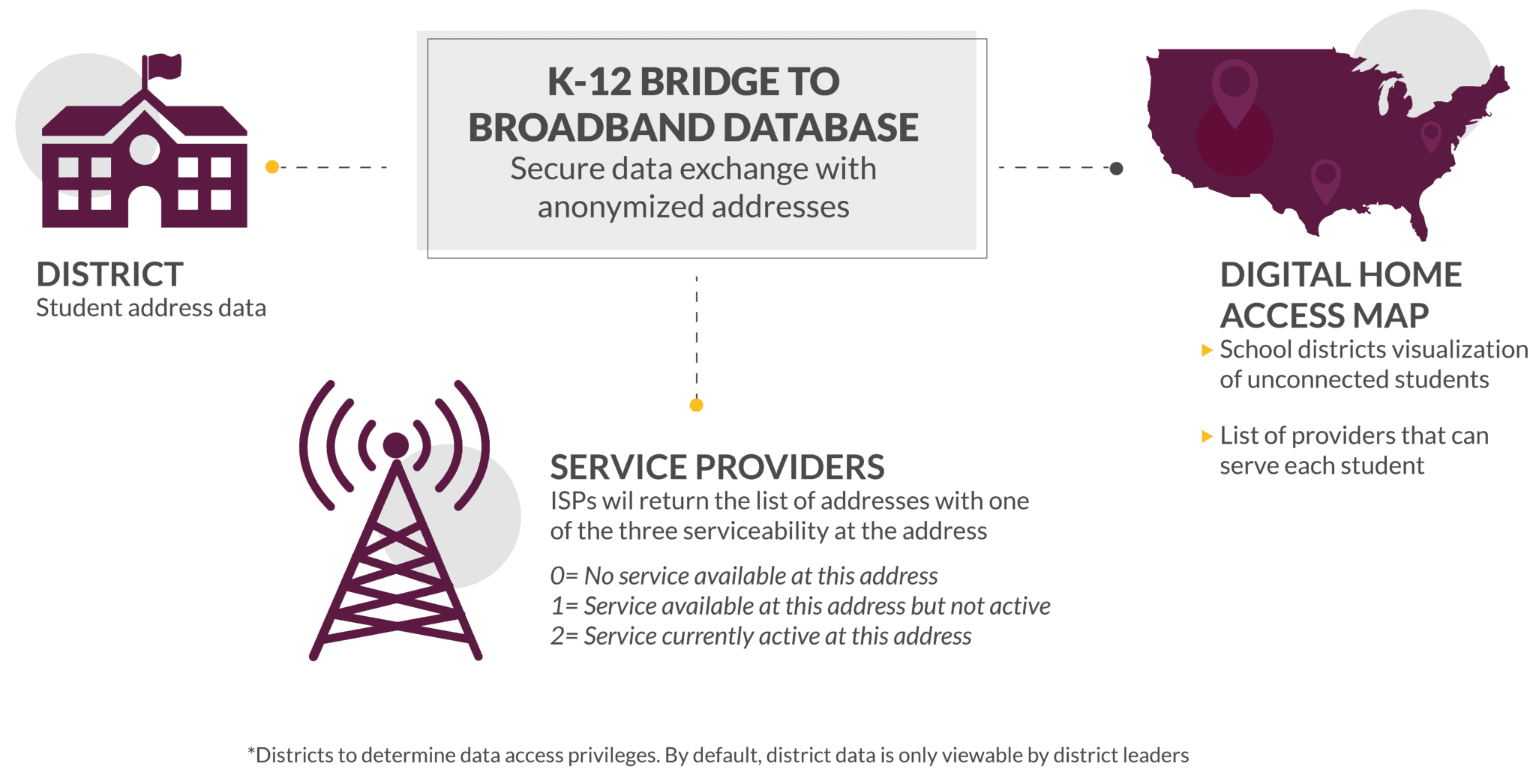With data sharing agreements in place, school districts share de-identified student addresses with ISPs using our Data Exchange Platform. ISPs confirm if they currently serve each address or if they can serve each address, resulting in a complete dataset that identifies unconnected student households. The program offers a route to rapidly identify and qualify K-12 household eligibility. Here is how it works:

State and school district leaders have weathered the COVID-19 pandemic with greater demands on their time and resources than ever before. We heard from countless states and districts that their attempts to gather student connectivity data through time-intensive calling campaigns and surveys to families were plagued with low participation and data inaccuracy challenges. When K-12 Bridge to Broadband was launched, the unprecedented commitment from ISPs to help identify unconnected students was viewed as a game-changer for providing actionable data to close the digital divide. States and school districts are seeking help from trusted partners like EducationSuperhighway to remove capacity constraints, provide technical and legal expertise and manage the numerous relationships with the ISPs to provide them with this critical data.
As a prerequisite to participate, ISPs will sign a non-disclosure agreement with EducationSuperHighway and designate a point of contact who can run the exchange. We will provide a standard template that can be reviewed and modified as necessary. The agreement is meant to protect the data supplied by both states/districts and ISPs: student addresses and proprietary information. After ISPs sign the agreement, EducationSuperHighway will schedule time with the point of contact to walk through the data exchange process.
Note that EducationSuperHighway will only provide the student addresses that overlap with each company’s covered territory as designated in FCC Form 477 data.
States or districts have used a combination of federal and state funding and private philanthropy to fund projects to connect student households. View a summary of federal funding available for K-12 home connectivity here, including $7.2 billion added to E-rate for home connectivity purchases and $130 billion for K-12 schools through the American Rescue Plan.
ISPs will use the Amazon Web Services (AWS) Client to download and return data in a CSV format. For each ISP, EducationSuperHighway will create a unique account with AWS Access Keys. The ISP will download and install the AWS Client. The ISP will use the AWS Access Keys and the AWS Client to download and return the CSV data.
For each student address, ISPs will designate one of the following codes to indicate subscriber information and service availability:
Active is defined as currently connected. ISPs should not include subscribers that are currently disconnected due to delinquent account billing status.
At a minimum, the data exchange process will be required up-front before states or districts can engage in procurement. Following the initial exchange, data exchanges are likely to be repeated annually to keep pace with family enrollment and adoption. Ultimately, the state or district will decide the cadence of ongoing exchanges.
State and school district leaders have weathered the COVID-19 pandemic with greater demands on their time and resources than ever before. We heard from countless states and districts that their attempts to gather student connectivity data through time-intensive calling campaigns and surveys to families were plagued with low participation and data inaccuracy challenges. When K-12 Bridge to Broadband was launched, the unprecedented commitment from ISPs to help identify unconnected students was viewed as a game-changer for providing actionable data to close the digital divide. States and school districts are seeking help from trusted partners like EducationSuperhighway to remove capacity constraints, provide technical and legal expertise and manage the numerous relationships with the ISPs to provide them with this critical data.
EducationSuperHighway has secured a commitment from over 100 Internet Service Providers that represent 90% of coverage in the country to participate in the K-12 Bridge to Broadband program. Participating providers are listed here.
If there are local or regional service providers in your area that have not yet committed to the program, EducationSuperHighway’s program team will work with you to get an agreement in place and engage them in the data exchange.
States and school districts share de-identified household address data with EducationSuperHighway. If states are sharing data on behalf of school districts, they will also include a field for the district NCES code. Specifically, the data fields required are:
For each student address, ISPs will designate one of the following codes to indicate subscriber information and service availability:
Active is defined as currently connected. ISPs should not include subscribers that are currently disconnected due to delinquent account billing status.
At a minimum, the data exchange process will be required up-front before states or districts can engage in procurement. Following the initial exchange, data exchanges are likely to be repeated annually to keep pace with family enrollment and adoption. Ultimately, the state or district will decide the cadence of ongoing exchanges.
As a result of the data exchange, states and school districts will receive three outputs: (1) raw data in CSV format that indicates which addresses are connected and for those that are unconnected, the providers that can serve those households, (2) a map that visualizes unconnected households and provider coverage, and (3) a dashboard view that captures the results of the data exchange.
No. As a non-profit organization, EducationSuperHighway provides support to all state, district, and service provider partners at no cost.
Please use this link to reach out to the EducationSuperHighway team to get started.
